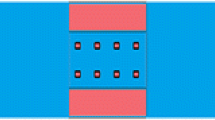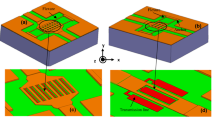Abstract
Previously, we proposed that the dielectric layer of RF MEMS switch can be fabricated either on the transmission line, as traditional switches, or on the lower surface of the bridge. This paper presents a detailed comparison of the RF MEMS switches with different positions of dielectric layer. Through theoretically analyzing the physical model of fringing capacitance, it is revealed that different positions of dielectric layer can result in different switch capacitances. Therefore, the change of dielectric-layer position can reduce the switch capacitance and insertion loss when the bridge is much wider than t-line. The theoretical analysis is demonstrated by Maxwell 3D and HFSS simulation, showing that the insertion loss is reduced by around 13% when the bridge width is three times of transmission line width. Further, the influence of switch’s structural parameters, such as dielectric material and dimensions of dielectric layer, on the differences between these two kinds of switches is discussed. To achieve high integration together with low-loss and low-actuation-voltage design, the novel switch with dielectric layer on bridge’s lower surface can be expected to have broad applications in the future.
Similar content being viewed by others
References
Hayden J S, Malczewski A, Kleber J, et al. 2 and 4-Bit DC-18 GHz microstrip MEMS distributed phase shifters. In: IEEE MTT-S Int Microwave Symp, Phoenix, AZ, USA, 2001. 219–222
Kim H T, Jung S, Kang K, et al. Low-loss analog and digital micromachined impedance tuners at the Ka-band. IEEE Trans Microw Theory Tech, 2001, 49: 2394–2400
Entesari K, Rebeiz G M. A 12–18-GHz three-pole RF MEMS tunable filter. IEEE Trans Microw Theory Tech, 2005, 53: 2566–2571
Vähä Heikkilä T, Rebeiz G M. A 20–50 GHz reconfigurable matching network for power amplifier applications. In: IEEE MTT-S Int Microwave Symp, Fort Worth, TX, USA, 2004. 717–720
Fakoukakis F E, Diamantis S G, Orfanides A P, et al. Development of an adaptive and a switched beam smart antenna system for wireless communications. In: Progress in Electromagnetics Research Symposium, Hangzhou, China, 2005. 276–280
Entesari K, Rebeiz G M. A differential 4-bit 6.5–10-GHz RF MEMS tunable filter. IEEE Trans Microw Theory Tech, 2005, 53: 1103–1110
Hayden J S, Rebeiz G M. 2-Bit MEMS distributed X-band phase shifters. IEEE Microw Guid Wave Lett, 2000, 10: 540–542
Rebeiz G M, Mudlavin J B. RF MEMS switches and switch circuits. IEEE Microw Mag, 2001, 2: 59–71
Goldsmith C L, Yao Z, Eshelman S, et al. Performance of low-loss RF MEMS capacitive switches. IEEE Microw Guid Wave Lett, 1998, 8: 269–271
Chang C, Chang P. Innovative micro-machined microwave switch with very low insertion loss. Sens Actuat A Phys, 2000, 79: 71–75
Peroulis D, Pacheco S P, Sarabandi K, et al. MEMS devices for high isolation switching and tunable filtering. IEEE MTT-S Int Microw Symp, 2000, 2: 1271–1274
Zhang J W, Jin Y F, Hao Y L, et al. Capacitive microwave MEMS switch. Chin J Semicond, 2005, 26: 1726–1730
Newman H S. RF MEMS switches and applications. In: 40th IEEE Annual Int Reliability Phys Symp, Dallas, TX, USA, 2002. 111–115
Rebeiz G M. RF MEMS Theory, Design, and Technology. New York: Wiley, 2003
Kamchouchi H E, Zaky A A. A direct method for the calculation of the edge capacitance of thick electrodes. J Phys D: Appl Phys, 1975, 8: 1365–1371
Silva A P D, Hughes H G. The package integration of RF-MEMS switch and control IC for wireless applications. IEEE Trans Adv Packag, 2003, 26: 255–260
Muldavin J B, Rebeiz G M. Inline capacitive and DC-contact MEMS shunt switches. Microw Wirel Compon Lett, 2001, 11: 334–336
Yao Z J, Chen S, Eshelman S, et al. Micromachined low-loss microwave switches. IEEE J Microelectr Syst, 1999, 8: 129–134
Calaza C, Margesin B, Giacomozzi F, et al. Electromechanical characterization of low actuation voltage RF MEMS capacitive switches based on DC CV measurements. Microelectr Eng, 2007, 84: 1358–1362
Peroulis D, Pacheco S P, Sarabandi K, et al. Electromechanical consideration in developing low-voltage RF MEMS switches. IEEE Trans Microw Theory Tech, 2003, 51: 259–270
Author information
Authors and Affiliations
Corresponding author
Rights and permissions
About this article
Cite this article
Chen, K., Zhang, J. Comparison of the RF MEMS switches with dielectric layers on the bridge’s lower surface and on the transmission line. Sci. China Inf. Sci. 54, 396–406 (2011). https://doi.org/10.1007/s11432-010-4179-2
Received:
Accepted:
Published:
Issue Date:
DOI: https://doi.org/10.1007/s11432-010-4179-2




